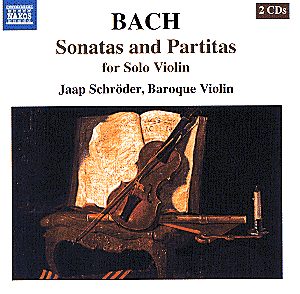This recording, made
in 1984 and 1985, was first released
c.1987 on the Smithsonian Institute
label. The village church of Oltingen
canton of Basel, Switzerland, a space
that seemed particularly favourable
to the sound and atmosphere of Bach’s
music, was chosen by Jaap Schröder
as the recording location. In the same
spirit he chose a Dutch baroque violin
and a baroque bow.
While much of Bach’s
music has a strong religious focus,
there are also other interesting religious/music
parallels exemplified by these Sonata
and Partitas. Each original composition
is represented by a multitude of interpretations,
arrangements and methods of execution
on variations of the same instrument.
There are often very strong and convincing
arguments for individual interpretations
and performances, but in the end there
is an element of truth in all. It was
Vladimir Nabokov who wrote "Remember
that what you are told is really three
fold - shaped by the listener, reshaped
by the teller, and concealed from both
by the dead man of the tale."
The superb notes by
Mr. Schröder deal with these matters
in some depth. Comparatively they are
far superior to those of any other recording
auditioned in conjunction with this
review, and reflect the understanding
of a master musician inspired by a work
of genius. To explore in detail the
fascinating history of these works,
the instrument on which they are played
and the various interpretive approaches
would be a delight; but too voluminous
and rather self indulgent in this forum
designed primarily to focus on review
of actual musical performance. For those
who purchase this new recording, Jaap
Schröder will take you on that
journey far more articulately than I
am able.
Mr. Schröder supplies
a good deal of information and justification
for the use of baroque instrumentation,
much of which has both intellectual
and common sense appeal. He comments
as follows:
"What seems
appropriate and right in one generation
becomes old-fashioned and will be rejected
in the next one, and no performance
style is able to escape the critical
judgement of a later period. It is not
the continually more detailed knowledge
about the past that is the severest
judge; it is the ever-changing conception
of taste, as applied in perfect good
faith in the interpretation of Bach’s
music. De gustibus non est
disputandum leads also to the conclusion
that the taste of today will inevitably
be deemed old- fashioned by the musicians
of the early twenty-first century"
In the same vein as
those readers of fiction who have a
propensity to read the last chapter
first, aficionados of these works, when
reviewing a new recording, will often
play first the Chaconne (Ciaccona) from
BWV 1004. This is the crowning glory
of the set. From this one may learn
a great deal about everything the musician
has to offer. Considered the most challenging
of music written for solo violin it
makes unprecedented demands on the performer’s
expressive, interpretive and technical
abilities.
The Chaconne’s vast
structure is based on sixty-four variations
of a single open-ended four-bar phrase.
Two sections in the minor enclose a
centre section in the major and the
movement displays almost every resource
of Bach and the violinist’s art. It
has been transcribed and arranged in
many contexts. Brahms arranged a piano
version for left hand only; Busoni made
a grand arrangement for piano; Andrès
Segovia transcribed it for classical
guitar; Leopold Stokowski did a full
orchestration; Nigel North arranged
it for Baroque lute.
After listening to
a variety of arrangements and transcriptions
and ten or so on the original instrument,
the most significant variation noted
is tempo. For good or for bad, this
has a profound effect on the reading.
Of the violinists the slowest rendition
is that of Hilary Hahn [17’74’] which
detracts from an otherwise magnificent
recording of BWV 1004 and 1006. Itzhak
Perlman comes a close second [15’46’],
with 14’30" being an average time.
The slowest time encountered was that
by guitarist Paul Galbraith [19’56’]
– Delos 3232. On the review recording
Jaap Schröder performs at a most
enjoyable tempo [13’50"] and gives
a first class account of himself in
this movement.
A thorough listening
to all of the Partitas and Sonatas on
the review disc leads one to the conclusion
that this is a fine recording by a master
musician who, over many years, has developed
a deep empathy and love for these masterpieces.
A major challenge as Mr. Schröder
so aptly describes it "Is the
ever changing conception of taste as
applied in perfect good faith to the
interpretation of Bach’s music."
Since this recording
was made, a number of outstanding young
players have added to the discography.
If this writer were to make an overall
observation (not criticism) relative
to the more recent recordings it would
be that in certain movements the newer
readings are much more "spirited",
an extra dimension to just intellectualisation.
There is no better illustration of this
than Hilary Hahn’s rendition of the
Prelude from BWV 1006 (Hilary Hahn Plays
Bach-Sony SK 62793). Lara St John also
gives the same impression in her playing
of the Chaconne from BWV 1004 (Lara
St John - Bach Works for Violin, Well
Tempered Productions WTP 5180). This
is arguably the finest reading available
in recorded format.
A reviewer once referred
to the interpretations of Mozart’s symphonies
by Swiss conductor Peter Maag as being
"for all time". Unencumbered
by musical fashion or whim, this is
an apt description for Schröder’s
interpretations.
This Naxos re-release
of Bach’s Partitas and Sonatas for unaccompanied
violin is, in every sense, a fine recording.
Especially worthy of acknowledgement
is the very warm sound of the Baroque
violin. The superb accompanying notes
by the musician are a "must read"
for anyone with an affinity for these
masterpieces.
Zane Turner
see also review
by Peter Lawson







